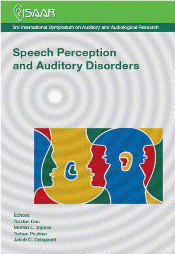Modelling the combined effect of binaural hearing and reverberation
Abstract
To study the interaction between the intelligibility advantage in rooms due to the presence of early reflections and due to the binaural blocking of interferers from undesired directions, a series of speech reception threshold (SRT) experiments was performed in a simulated room and with a single early reflection of the frontal target speech source as a function of its delay ranging from 0 to 200 ms. From the data and the model considerations given here, one can conclude that binaural unmasking and temporal integration of reflections seem to be comparatively independent from each other, thus providing evidence for a model with a binaural processing stage as a frontend and a reverberation compensation stage (like the MTF model) as the subsequent, independent stage. However, a blocking effect was found for reflections ipsilateral to the noise direction and a release from the deterioration effect at 200 ms delay was found for all non-blocked reflections from azimuths deviating from the midline. These findings are at odds with three versions of a model of binaural speech intelligibility in rooms described here.
References
Beutelmann, R., Brand, T., and Kollmeier, B. (2010). “Revision, extension, and evaluation of a binaural speech intelligibility model” J. Acoust. Soc. Am. 127, 2479-2497.
Beutelmann, R., and Brand, T. (2006). “Prediction of speech intelligibility in spatial noise and reverberation for normal-hearing and hearing-impaired listeners” J. Acoust. Soc. Am. 120, 331-342.
Bronkhorst, A. (2000). “The cocktail party phenomenon: A review of research on speech intelligibility in multiple-talker conditions” Acustica 86, 117-128.
Durlach, N. I. (1972). “Binaural signal detection: Equalization and cancellation theory” Foundations of Modern Auditory Theory, edited by J. Tobias (Academic, New York), Vol. II, 371-462.
Kuttruff, H. (2009). ”Room acoustics” 5th edition, (Taylor & Francis, New York).
Lavandier, M., and Culling, J. F. (2010). “Prediction of binaural speech intelligibility against noise in rooms" J. Acoust. Soc. Am. 127, 387-399.
Lavandier, M., Culling, J. F., and Jelfs, S. (2010). “Prediction of reverberant speech intelligibility against multiple noise interferers in rooms: Binaural useful-to- detrimental ratios (A)” J. Acoust. Soc. Am. 128, 2361.
Lochner, J. and Burger, J. (1964). “The influence of reflections on auditorium acoustics” J. Sound Vib. 1, 426-454.
Peissig, J. and Kollmeier, B. (1997). “Directivity of binaural noise reduction in spatial multiple noise-source arrangements for normal and impaired listeners" J. Acoust. Soc. Am. 101, 1660-1670.
Rennies, J., Brand, T., and Kollmeier, B. (2011). “Prediction of the inuence of reverberation on binaural speech intelligibility in noise and in quiet" J. Acoust. Soc. Am. (in press).
Steeneken, H. J. M. and Houtgast, T. (1980). “A physical method for measuring speech-transmission quality" J. Acoust. Soc. Am. 67, 318-326.
van Wijngaarden, S. J., and Drullman, R. (2008). “Binaural intelligibility prediction based on the speech transmission index” J. Acoust. Soc. Am. 123, 4514-4523.
vom Hövel, H. (1984). “Zur Bedeutung der Übertragungseigenschaften des Außenohres sowie binauralen Hörsystems bei gestörter Sprachübertragung" (On the importance of transmission properties of the outer ear and the binaural auditory system for disturbed speech transmission), doctoral dissertation, RWTH Aachen.
Wagener, K., Brand, T., and Kollmeier, B. (1999). “Entwicklung und Evaluation eines Satztests für die deutsche Sprache II: Optimierung des Oldenburger Satztests (Development and evaluation of a German sentence test II: Optimization of the Oldenburg sentence test)" Z. Audiol. 38, 44-56.
Warzybok, A., Rennies, J., Brand, T., Doclo, S. and Kollmeier, B. (2011). “Effects of spatial and temporal integration of early reflections on speech intelligibility” J. Acoust. Soc. Am. (submitted).
Additional Files
Published
How to Cite
Issue
Section
License
Authors who publish with this journal agree to the following terms:
a. Authors retain copyright* and grant the journal right of first publication with the work simultaneously licensed under a Creative Commons Attribution License that allows others to share the work with an acknowledgement of the work's authorship and initial publication in this journal.
b. Authors are able to enter into separate, additional contractual arrangements for the non-exclusive distribution of the journal's published version of the work (e.g., post it to an institutional repository or publish it in a book), with an acknowledgement of its initial publication in this journal.
c. Authors are permitted and encouraged to post their work online (e.g., in institutional repositories or on their website) prior to and during the submission process, as it can lead to productive exchanges, as well as earlier and greater citation of published work (See The Effect of Open Access).
*From the 2017 issue onward. The Danavox Jubilee Foundation owns the copyright of all articles published in the 1969-2015 issues. However, authors are still allowed to share the work with an acknowledgement of the work's authorship and initial publication in this journal.


